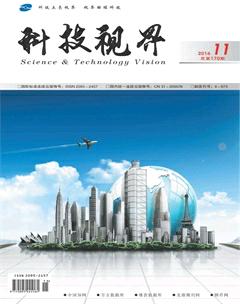Algal biomass production and carbon fixation from flue gas
WANG+Ling ZHU+Jing
【Abstract】Algal biofuel has established as one of renewable energy. In this study, Nannochloropsis salina was cultured to test feasibility of biomass production and CO2 fixation from flue gas. Firstly, cultivation was conducted under different light intensity. Results showed that the highest dry biomass of 1.25±0.061 g/L was achieved at light intensity of 10klux, while the highest total lipids was 33.677±1.9% at light intensity of 15klux. The effect of mercury on algae growth was also investigated, the algae growth was serious limited at the presence of mercury, and there was no any difference at the range of 10-50 ug/m3. These results provide useful information for algal biomass production and CO2 fixation from flue gas.
【Key words】Algal biofuel; CO2 fixation; Flue gas
0 Introduction
Currently, more and more attention has been pained to CO2 sequestration and conversion, due to serious environmental problems induced by the increase of carbon dioxide(CO2)concentration in the atmosphere. Therefore, many methods have been developed to fix CO2. Among them, biological conversion of CO2 by microalgae has been established as the most attractive methods due to its high efficiency of CO2 conversion, producing significant amount of biomass.
Although, microalgal-based CO2 fixation and biomass production are promising, it still has long way before its application. There are many reasons accounting for this, such as high temperature and presence of toxic pollutants, including mercury, (Lam, Lee et al. 2012). On the hand, high CO2 concentration can also have a negative effect on algal growth (Mudimu, Rybalka et al. 2015).
In present study, Nannochloropsis salina was bath cultured to achieve higher carbon fixation efficiency and algal biomass productivity. Growth and biomass productivity were tested under different light intensity, and the lipid content of algae cell was also investigated. Meanwhile, the effects of different mercury concentrations on the algal growth were studied. This study provides useful information for algal biofuel production in future.
1 Materials and Methods
1.1 Microalgae strain and culture medium
The Nannochloropsis salina was purchased from Culture Collection of Autotrophic Organisms(CCALA), Academy of Sciences of the Czech Republic. It was cultivated in artificial seawater medium.
1.2 Culture system and culture condition
Nannochloropsis salina was batch cultivated in column reactor with broth of 0.6L.The whole culture were operated in constant temperature room, where the air temperature was controlled at 30±1℃. Stirring and carbon source was carried out by sparing simulated flue gas with rate of 15Lmin-1, which contains 15% of CO2. All cultures were maintained at the same initial cell concentration of 0.1g/L, and the culture process was set as 12 days.
1.3 Experimental design of algae cultivation
Firstly, the effect of light intensity on algal growth was investigated, where the light intensity was illuminated from one side and set as 3klux, 8klux 10kux and 15klux. Different concentration of mercury chloride was added to medium to survey effect of mercury on algae culture.
1.4 Analytical determinations
Dry biomass concentration was measured. 20 mL culture was centrifuged at 6,000 g for 5 min and cell pellet was then washed twice with ammonium bicarbonate. After that, the cell pellet was dried in glass dish at 80℃ for 12h. The weight of glass petri-dish was subtracted from the measured total weight to dry biomass. The total lipid content was measured using a rapid method(Mishra, Suh et al. 2014).
2 Results and discussions
2.1 Effect of light intensity on algae growth and lipids accumulation
As showed in Fig.1, the effect of four light intensity of 3klux, 8klux, 10klux and 15 klux, was investigated, and final biomass was 1.13±0.001g/L, 1.21±0.013g/L, 1.25±0.061g/L and 0.655±0.038g/L, respectively. Meanwhile, the total lipids content was also measured. As showed as Fig.2, the total lipids content was 21.52±1.3%, 24.97±1.77%, 26.65±0.6%, 33.677±1.9%, respectively. According to the results, we can conclude that the lipids accumulation can be enhanced by increasing light intensity.
Fig.1 algae growth under different light intensity
Fig.2 Total lipids content in algal cell under different light intensity
2.2 Performance of microalgae candidates in response to mercury levels
Fig.3(下转第266页)
(上接第235页)The effect of mercury on algae was investigated. As we can see in the Fig.3, the final biomass concentration was 1.13±0.02g/L,0.451±0.038g/L, 0.421±0.028g/L and 0.417±0.003g/L, respectively. Actually, the algae growth was serious inhibited even at the lower concentration of mercury. What is more, the effect of mercury on algae growth was no difference in concentration range of 10-50ug/m3. Based on this result, we can conclude that the mercury should be controlled before using flue gas for algae cultivation.
3 Conclusion
In present investigation, Nannochloropsis salina was successfully cultured with the highest dry biomass of 1.25±0.061g/L, while the highest total lipids was 33.677±1.9%, providing useful information for biofuel production.
【References】
[1]Lam, M. K., K. T. Lee and A. R. Mohamed(2012). Current status and challenges on microalgae-based carbon capture[J]. International Journal of Greenhouse Gas Control, 10: 456-469.
[2]Mishra, S. K., W. I. Suh, W. Farooq, M. Moon, A. Shrivastav, M. S. Park and J.-W. Yang(2014). Rapid quantification of microalgal lipids in aqueous medium by a simple colorimetric method[J]. Bioresource Technology, 155: 330-333.
[3]Mudimu, O., N. Rybalka, T. Bauersachs, T. Friedl and R. Schulz(2015)[Z]. Influence of Different CO2 Concentrations on Microalgae Growth, alpha-Tocopherol Content and Fatty Acid Composition. Geomicrobiology Journal, 32(3-4): 291-303.
[责任编辑:杨玉洁]

